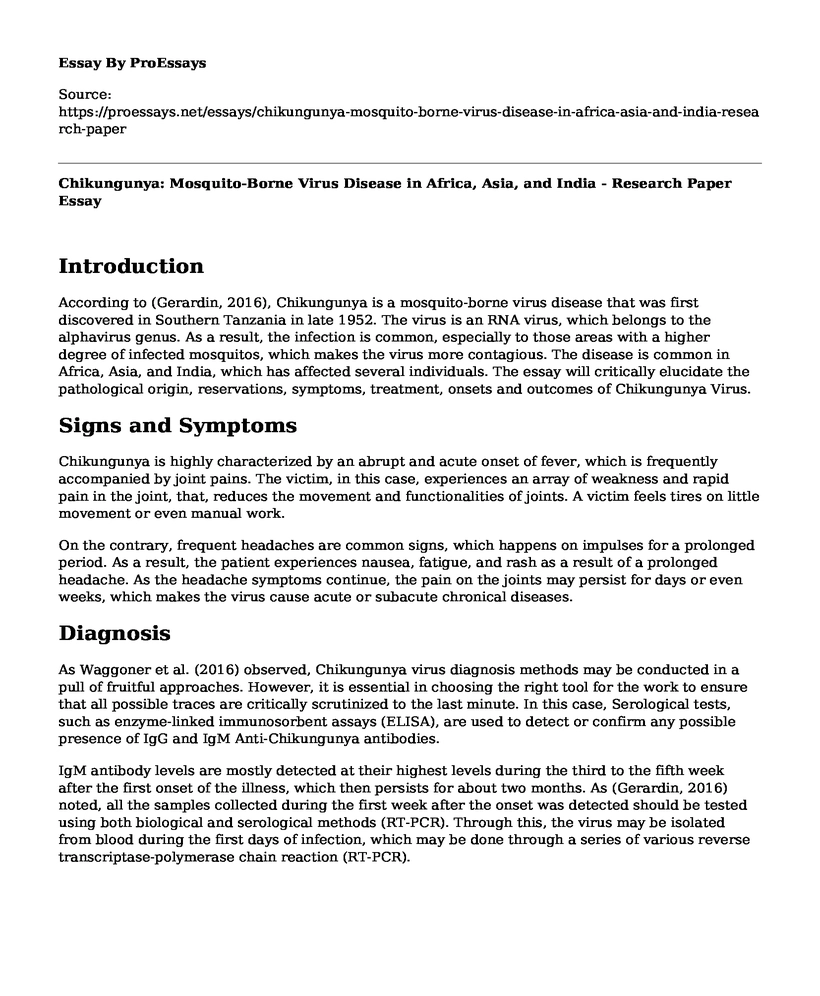Introduction
According to (Gerardin, 2016), Chikungunya is a mosquito-borne virus disease that was first discovered in Southern Tanzania in late 1952. The virus is an RNA virus, which belongs to the alphavirus genus. As a result, the infection is common, especially to those areas with a higher degree of infected mosquitos, which makes the virus more contagious. The disease is common in Africa, Asia, and India, which has affected several individuals. The essay will critically elucidate the pathological origin, reservations, symptoms, treatment, onsets and outcomes of Chikungunya Virus.
Signs and Symptoms
Chikungunya is highly characterized by an abrupt and acute onset of fever, which is frequently accompanied by joint pains. The victim, in this case, experiences an array of weakness and rapid pain in the joint, that, reduces the movement and functionalities of joints. A victim feels tires on little movement or even manual work.
On the contrary, frequent headaches are common signs, which happens on impulses for a prolonged period. As a result, the patient experiences nausea, fatigue, and rash as a result of a prolonged headache. As the headache symptoms continue, the pain on the joints may persist for days or even weeks, which makes the virus cause acute or subacute chronical diseases.
Diagnosis
As Waggoner et al. (2016) observed, Chikungunya virus diagnosis methods may be conducted in a pull of fruitful approaches. However, it is essential in choosing the right tool for the work to ensure that all possible traces are critically scrutinized to the last minute. In this case, Serological tests, such as enzyme-linked immunosorbent assays (ELISA), are used to detect or confirm any possible presence of IgG and IgM Anti-Chikungunya antibodies.
IgM antibody levels are mostly detected at their highest levels during the third to the fifth week after the first onset of the illness, which then persists for about two months. As (Gerardin, 2016) noted, all the samples collected during the first week after the onset was detected should be tested using both biological and serological methods (RT-PCR). Through this, the virus may be isolated from blood during the first days of infection, which may be done through a series of various reverse transcriptase-polymerase chain reaction (RT-PCR).
Treatment
As Powers (2018) observed, there is no specific treatment currently adopted for the Chikungunya Virus. However, the procedure is directed primarily at revealing the symptoms from the patient, which includes headache and joint pains. The patient is administered an antipyretic, optimal analgesics and fluids that help in reducing the pain in the joints. Despite the medical advancement, in curbing significant life-threatening viruses, there is no commercial chikungunya vaccine.
According to the report published by (Waggoner et al., 2016), the primary source of Chikungunya virus sources, were noted to be emanating from proximity mosquito vector breeding sites. Most of these sites were closer to human habitations, which leads to higher risks of contaminations and higher possibilities of incubating the virus. However, the most prevalent method of preventing this concept relies on the prevention and controlling of the number of natural and artificial water-filled areas that supports the breeding of the mosquitoes.
On the contrary, during the outbreak, it is essential to spray insecticides, to help kill the infected mosquitoes, and early larvae. On the contrary, clothing with minimal body exposure is suitable to prevent the skin from coming in contact with the dangerous mosquitos.
References
Gerardin, P., Couderc, T., Bintner, M., Tournebize, P., Renouil, M., Lemant, J., ... & Lecuit, M. (2016). Chikungunya virus-associated encephalitis: A cohort study on La Reunion Island, 2005-2009. Neurology, 86(1), 94-102. doi: 10.1212/WNL.0000000000002234.
Powers, A. M. (2018). Vaccine and therapeutic options to control the Chikungunya virus. Clinical microbiology reviews, 31(1), e00104-16. doi: 10.1128/CMR.00104-16.
Waggoner, J. J., Gresh, L., Vargas, M. J., Ballesteros, G., Tellez, Y., Soda, K. J., ... & Pinsky, B. A. (2016). Viremia and clinical presentation in Nicaraguan patients infected with the Zika virus, chikungunya virus, and dengue virus. Clinical Infectious Diseases, ciw589. DOI: 10.1093/cid/ciw589
Cite this page
Chikungunya: Mosquito-Borne Virus Disease in Africa, Asia, and India - Research Paper. (2023, Mar 23). Retrieved from https://proessays.net/essays/chikungunya-mosquito-borne-virus-disease-in-africa-asia-and-india-research-paper
If you are the original author of this essay and no longer wish to have it published on the ProEssays website, please click below to request its removal:
- The Epidemiology of Tuberculosis in the U.S. Essay
- Essay Sample on Genetic Tests for Cancer Risk Genes
- Student's Well Being Quantitative Study Paper Example
- Evidence-Based Program: A Guide to Caring Techniques for Nurses
- Essay Sample on "Nursing Care for Mary Craig: Evidence-Based Approach to Treating Type II Diabetes"
- Non-Pharmacologic Pain Management: Individualized Treatment Strategies - Essay Sample
- Research Paper Sample on COVID-19: Global Pandemic Causes Global Paralysis







